
It was just before 6am when the tuk tuk we’d arranged the night before arrived. We’d been waiting in the lobby with our bags. I tossed them in and asked him to take us to the bus station.
We didn’t expect Phonsavanh to be so cold in the morning. It must have been close to freezing and we were wearing shorts and sandals. We never went over 30kph, but the tuk tuk was open to the elements and our teeth were chattering when we arrived at the bus station on the outskirts of town.
We showed our tickets and shoved our bags underneath the bus. Oksana climbed aboard to claim our seats while I looked over the snacks at the station kiosks. I started up a conversation with the only other tourists in sight. Derek and Paulien were from the Netherlands and had just traveled through all the same places we’d been, going all the way back to Phuket, in Thailand. When I asked them if they were going to Vietnam, too, they looked relieved. It always feels good when you get independent verification about the bus you’re about to get on.
Shortly we were underway, but our driver took us on a tour of Phonsavanh before pointing us in the direction of Vietnam. By the time we’d arrived at the border, I’d read a few chapters of my dog-eared copy of Kitchen Confidential and watched a movie on my iPhone.
The Laotian side was nothing more than a concrete corridor with a row of windows along one side. Unaware of the protocol, Derek, Paulien, Oksana and I neglected to add our passports to the stack from our bus, so we were the last to get our exit stamps. Bringing up the rear, we hefted our bags and hiked across the border.
The immigration office on the Vietnamese side was a different beast altogether. High-ceilinged and full of echoes, we gawked a bit when we entered. Instead of the loops and swirls of Laotian, the signage was written in a Roman-derived alphabet. The plentiful and peculiar accent marks were the only clue that one should not pronounce them without first learning more about the language.
Beyond the tall glass doors, a long counter sat in the sunlight. As we entered, an official behind the desk pointed to a waiting area with rows of airport-style plastic chairs. I set my bags down in front of one, turned back, and raised my eyebrows. Here?
He gave a curt nod, made a stamping gesture with his hand, and beckoned me over. Derek and I walked all four of our passports over. As soon as they were on his desk, he shoo’d us away. We walked back to our seats.
Fifteen minutes later, Derek asked if they were just trying to make us sweat. I wasn’t worried. Everyone else from our bus was sitting off to the left and they hadn’t received their passports back yet, either.
With nothing to do but wait, I examined the border control station. The building itself wasn’t falling apart, but neither had it been maintained. Up near the ceiling, a patch of mold had grown to enormous proportions. It was as if the jungle outside was reclaiming its territory and had established a beachhead by boring a hole through the wall.
I dropped my gaze to observe the three men behind the desk. In contrast to the state of the building, their uniforms were immaculate. Medals, epaulettes, and rank insignia burst with vibrant color. Creases were crisp, boots shined with a mirror finish, and even the hair beneath their smart peaked caps were cut and parted with military precision. While I was watching them, the most dour and serious looking one of them all caught my eye. He snapped his head to the left, summoning me to the counter. I glanced at my traveling companions, widened my eyes in surprise, and got up.
The officer held my eyes as I approached. When I reached him, I didn’t know what to say – didn’t even know if he even spoke English. I simply raised my eyebrows questioningly.
He slid an old piece of paper across the desk. It had been folded and refolded many times, the edges worn away. It took me a moment to make out the handwriting, “Would you like to exchange some Laotian Kip for Vietnamese Dong?”
I looked up from the piece of paper. He raised a single eyebrow. The corners of my mouth may have twitched, but I held in the smile. “What exchange rate?” I asked.
He pulled the piece of paper back below the level of the counter and walked over to one of his coworkers. I waited while they conferred. He came back, flipped the paper upside down, and wrote, “10,000k = 20,000d.” It should have been 25,000. I nodded once, held up my index finger, and returned to my seat to confer with the others.
Derek and Paulein had no Laotian kip left at all, so they were out. Oksana and I had spent most of the rest of ours loading up on bus snacks, but I did still have 30,000 kip in my pocket. Normally, we rankle at being cheated on the exchange rate – especially at border crossings, where scams abound – but 30,000 kip is less than four dollars and, well, who knows? We still hadn’t received our passports back and exchanging some money under the table might just help grease the skids.
I walked back up to the counter and slid the money across. He counted it out and returned to his fellow officer. If he was disappointed with how little we had to exchange, it didn’t show. He came back and handed me 60,000 dong. I counted it, nodded, and returned to my seat.
A few minutes later, everyone was beckoned to the counter to receive their freshly-stamped passports. We shouldered our bags again and walked out the other side of the building. Our bus driver was waiting there for us.
That 60,000 dong didn’t last very long, but it ended up being useful. We couldn’t find an ATM at our first rest stop in Vietnam, but we were still able to buy a Coke and to pay for a restroom with it.
Transportation
When we crossed the border from Laos to Vietnam, I hadn’t expected to see much of a difference from the road, but there were a couple things that were immediately apparent.
Speed
First, our speed dropped considerably (and in Laos, we weren’t going that fast to begin with!) The mountain roads in Vietnam, at least on our route, were not in bad shape at all. Twisty, yes, but they were well-paved and often had guard rails or earthen mounds around some of the more dangerous curves.
Still, the bus slowed to a crawl. I’d be surprised if our average speed from the border, all the way to Vinh, was any more than 30 miles-per-hour (50kph.) Much of the reason for this was two-fold. Narrow roads – that is to say, no passing lanes – and a plethora of scooters. Scooter drivers did their best to keep to the shoulder, but to pass them, our bus still had to wait for a gap in the oncoming traffic.
Every bus we took in Vietnam arrived late. Hours late. It didn’t matter if it was supposed to be a three-hour bus ride or an eleven-hour bus ride; it got to the point where I would mentally prepare myself by doubling whatever travel time was quoted.
Scooters
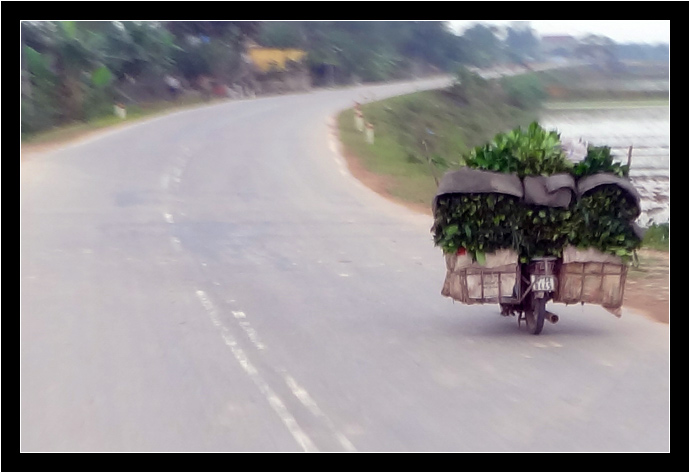
The second thing I noticed when we crossed the border into Vietnam was, of course, the scooters. Vietnam is renowned for the number of motorbikes on the road, but up in the mountains, there didn’t seem to be many more than in Laos. The way they were used, however…
I can’t believe how much a Vietnamese can pile onto a scooter! I saw contraptions that strapped together stacks of boxes, starting from the rear wheel and climbing up both sides until they towered over the driver. I saw families of 4 and 5 on the same moped. I saw some scooters loaded down so heavily that they could only be balanced while moving forward. Unbelievable as it may sound, scooters are the moving trucks of Vietnam!

Later, in Hanoi and Saigon, the scooters flowed like a river down every street. There were very few stoplights, and fewer crosswalks still, so if you wanted to walk anywhere, you quickly had to learn how to cross the street.
You can’t wait for a gap in the traffic; with 20 million scooters in Vietnam, there are no gaps in the traffic. Looking both ways before crossing is useless because as soon as you look away, you can bet another motorcycle will be coming along. To cross a street in Vietnam, you have to put your trust in the drivers.
It’s simple, really. So simple, in fact, that I honestly do think you could cross a busy street in Vietnam while blindfolded. You might still die of a heart attack, but I doubt you’d be hit…
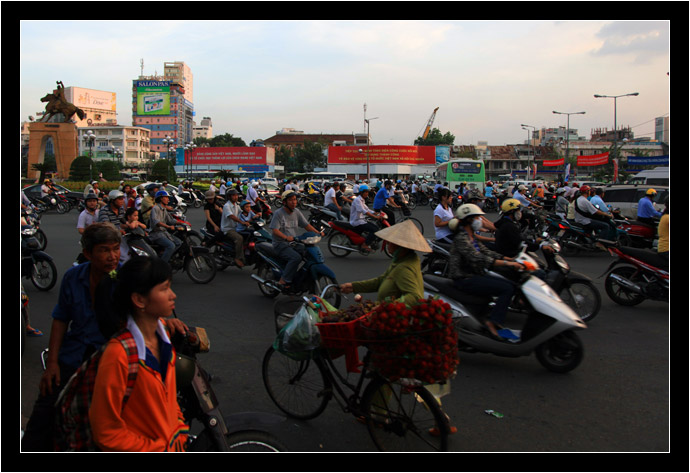
The trick is to just go slow. You can step off the curve at any time, but you want to be facing into traffic. Start walking slowly across the street – don’t move in fits and starts, trying to avoid the dozens of scooters going past – just move at a steady pace. Like magic, the traffic will part around you.
When you reach the middle, simply turn your head to face the traffic coming from the opposite direction; you don’t even need to stop. Scooters will be zipping by, a foot to your left and a foot to your right, at all times, but as long as you don’t make any surprise movements, the drivers will see you coming and move to avoid hitting you.
I would love to get a birds-eye view of a person crossing a busy Vietnamese street. I think it would look like rolling a boulder across a river.
Oksana and I rented a scooter in Laos, but we weren’t about to in Vietnam. The idea of navigating through all that traffic scared the hell out of me. As scary as it seemed to me, I’m confident that your typical Vietnamese driver would be just as terrified to drive in the United States. Our rigid rules of the road allow us to drive at much higher speeds and putting them on a Los Angeles freeway at 80 miles-per-hour is likely just as frightening for them as riding in the middle of a hundred scooters is for us.
Sleeper buses
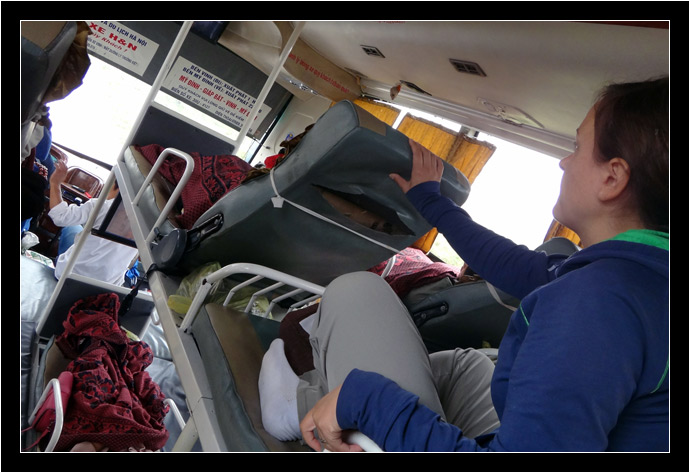
When I heard some of the buses in Vietnam being called “sleeper buses,” I assumed they’d be like the ones we had in Peru, Argentina, and Chile. There, they were called semi-cama and cama total, semi-bed and full-bed, depending on how far back the seats reclined.
Even though we were traveling during the day, we found ourselves hustled onto a sleeper bus for our trip from Vinh to Hanoi. Imagine our surprise when we discovered that it was full of bunk beds! There were three rows of beds stacked above one another. Oksana was berated at the door because she didn’t take her shoes off before heading down one of the two aisles…
The seats themselves were more like lawn chair recliners than bus seats. There was no way to put your feet on the floor. In fact the only way to bend your knees at all was to fold your legs and point them up in the air. The seats were comfortable enough, I suppose, if you’re lucky enough to be shorter than my 5-foot, 12-inch frame. I couldn’t stretch my legs out for the entire duration of the (double-what-was-quoted) bus ride.
Horns
Vietnam has the most annoying horns I’ve ever heard, and after traveling through 30 countries, that’s really saying something! There’s one custom job in particular that grated on my nerves every time I heard it. Try to imagine a fast staccato bleating that starts out loud, and over the course of three or four seconds, fades away to nothing. BAAA-DAAA-daaa-daaa-daaa-daaa-daaa-daaa-daaa-daaa-daaa-daaa-daaa.
Because the rules of the road are very loose, and drivers are always jockeying for position, the horns are constantly blaring. “I’m on your left: BAAA-DAAA-daaa-daaa-daaa-daaa-daaa-daaa-daaa-daaa-daaa-daaa-daaa.” “I’m going to pass now: BAAA-DAAA-daaa-daaa-daaa-daaa-daaa-daaa-daaa-daaa-daaa-daaa-daaa.” “My taxi is yellow: BAAA-DAAA-daaa-daaa-daaa-daaa-daaa-daaa-daaa-daaa-daaa-daaa-daaa.”
Surgical Masks
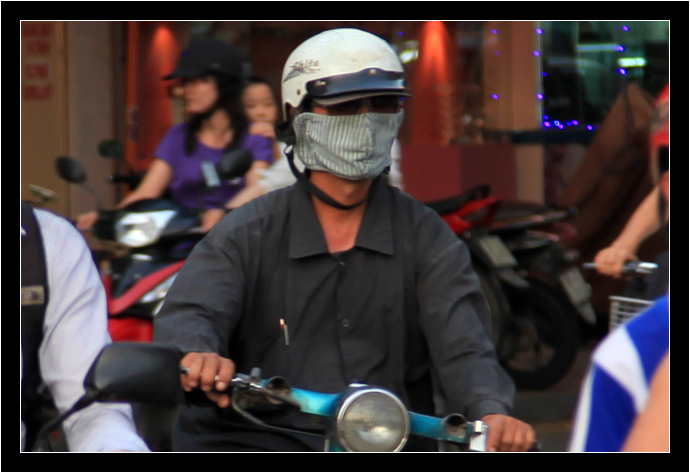
All over Southeast Asia, you’ll see people wearing surgical masks as they go about their business. I always assumed it had something to do with an illness – either the person was sick and was doing their selfless part to keep from spreading it, or perhaps they had a touch of hypochondria and worried about catching a bug themselves. With such a dense population in the cities (not to mention a possible lack of medicine or health care), it seemed a reasonable explanation.
After seeing so many street sweepers, traffic cops, and scooter owners with them, however, I now think it may just be a way to protect the lungs from rampant air pollution from all that exhaust.
Then again, for all I know, it could be an allergen-filter. Call it the Southeast Asian’s Claritin.
Language
We got into a huge argument with a taxi driver in Vinh. We asked our hotel to call us a taxi and tell him to take us (Derek, Paulien, Oksana and I) to the bus station. Everything was going great until we drove right past the bus station. I tried to tell him, “Um, hey, that’s where we wanted to go,” and he just smiled and nodded. We all figured it had something to do with one-way streets; maybe he had to throw a U-turn at the light before he could pull into the station. We knew something was wrong by the time we were another mile or two down the road. We were all grumbling, but he was still oblivious to our mood when he pulled into the train station.
“No. No. Not here. Bus station. Bus.” I was sitting up in the passenger seat, so it fell to me to try to communicate where we wanted to go. “Bus! Bus!” Nowhere else in the world had a taxi driver failed to understand the word ‘bus!’
Lucky for us, a bus drove by and he finally got the message when all four of us started pointing and shouting. He drove us back to the bus station.
When we finally arrived, however, he demanded the fare on the meter. Oh, that pissed us off. I had pointed out the bus station as we went by and he’d ignored me. We were all giving him signals of confusion and displeasure on the way to the train station, too. We started to argue about the payment.
We got nowhere. We couldn’t understand him and he couldn’t understand us. Actually, that’s not altogether true. We were able to understand that the receptionist at the hotel told him to take us to the train station, but he wouldn’t understand that we only wanted to pay what the meter had said when we first passed the bus station.
Now, granted, understanding someone who’s speaking a foreign language is a learned skill – it’s a lot like playing charades. But dammit, he was a taxi driver! He should have had plenty of practice! It was like he was willfully ignoring our gestures, not to mention the simple words we were saying. Oksana was already out of the car, waiting in the rain, when we realized we were vehemently arguing over all of three dollars. Split two ways. Paulein and I paid up and slammed his doors on our way out.
I wasn’t mad at him for not understanding us. I was mad at him for not trying to.
Vietnam was often like that. People were very hard to understand, more so than in any other country we visited. It probably comes down to the fact that English was not a language that was really pursued until about 20 years ago (when the Soviet Union fell and Vietnam lost its communist support.)
Any person over the age of 50 or 60 in Vietnam has certainly seen a lot of changes to secondary languages in the country. From Chinese, to French, to Russian, to English.
Because the U.S. occupied the south for so long, English fluency is often higher in Saigon. Both hostels we stayed at had receptionists who could hold a conversation. I asked the girl at the second where she learned her English and she told me, “At the park.” Turns out she wanted to learn English, so she went to the park every day and talked to tourists. Not a single formal lesson. At first, she didn’t understand a word. That was a year or so ago. Now she can carry on a conversation about any topic you like. I was very impressed; perhaps more so because her English was damn near the best I heard in Southeast Asia.
The exception that proves, the rule, I guess.
One morning in Hanoi, I found myself reading about the Vietnamese language in a Lonely Planet guide. There were too many cool bits that I wanted to share, so rather than trying to summarize, I thought I’d quote a paragraph or seven [boldface is mine]:
The Latin-based quốc ngử script, widely used since WWI, was developed in the 17th century by Alexandre Rhodes […] Quốc ngử served to undermine the position of Mandarin officials, whose power was based on traditional scholarship, [Chinese and Chinese-derivative] scripts that were largely inaccessible to the masses.
The Vietnamese treat every syllable as an independent word, so ‘Saigon’ is spelt ‘Sai Gon’ and ‘Vietnam’ is written as ‘Viet Nam’. Foreigners aren’t too comfortable with this system — we prefer to read ‘London’ rather than Lon Don. This leads to the notion that Vietnamese is a ‘monosyllabic language’, where every syllable represents an independent word. This idea appears to hark back to the Chinese writing system, where every syllable is represented by an independent character and each character is treated as a meaningful word in its own right. In reality, Vietnamese appears to be polysyllabic, like English. However, writing systems do influence people’s perceptions of their own language, so the Vietnamese themselves will insist that their language is monosyllabic — it’s a debate probably not worth pursuing.
PRONUNCIATION
Most of the names of the letters of the quốc ngử alphabet are pronounced like the letters of the French alphabet. Dictionaries are alphabetised as in English except that each vowel/tone combination is treated as a different letter.
Most of the consonants of the Romanised Vietnamese alphabet are pronounced more or less as they are in English with a few exceptions. Vietnamese doesn’t use the English letters ‘f’, ‘j’, ‘w’ and ‘z’.
TONES
The hardest part of studying Vietnamese for Westerners is learning to differentiate between the tones. There are six tones in spoken Vietnamese. Thus, every syllable in Vietnamese can be pronounced six different ways. For example, depending on the tones, the word ma can be read to mean ‘phantom’, ‘but’, ‘mother’, ‘rice seedling’, ‘tomb’ or ‘horse’.
The six tones of spoken Vietnamese are represented by five diacritical marks in the written language (the first tone is left unmarked). These should not be confused with the four other diacritical marks that are used to indicate special consonants and vowels.
The following examples show the six different tone representations:
~Lonely Planet Vietnam, 9th Edition
Scams
One night in Luang Prabang, we were going over our Vietnam plans in a bar. An American couple overheard and decided to share with us their recent experiences in the country. To hear them tell it, they were scammed at every opportunity. Eventually, they got fed up, cut their trip short, and fled back to Laos, even though it cost them a couple hundred dollars extra to do so. They had horror stories about being taken for a ride in Halong Bay, about being sold bus tickets that only took them half way to their destinations, and about being short-changed with every monetary transaction. Their story was bad enough to make us seriously consider skipping Vietnam altogether.
Fortunately, I bounced that idea off my Facebook friends, and many of them wrote back about the wonderful experiences they’d had in the country. It was enough to convince us to go, though you can bet we went in with our eyes wide open.
We ended up pleasantly surprised (although that may only have been because we went in expecting it to be as bad as Egypt.) We did notice a lot of the penny ante bullshit that comes with being a tourist. Inflated prices, cab drivers taking the long way around, those sorts of things. We may have paid a bit more than we should have from time to time, but I don’t think we were ever outright scammed. (That taxi incident in Vinh really was an honest mistake.)
Of course, after traveling for a year, Oksana are I were seasoned travelers. We knew a two-day Halong Bay cruise could be had for under $50 each, but after hearing what that American couple had to put up with, we opted to pay a $120 “non-negotiable” price for a set tour from our hotel. (I put “non-negotiable” in quotes because we actually got them to knock $10 off the price – matching a cheaper tour we wanted that was already booked – but they made us promise not to tell anyone.)
I don’t know. That couple back in Luang Prabang could have been naive, too trusting, or just had a run of extremely bad luck. Yes, I’d say you have to be more careful with your money in Vietnam than in the rest of Southeast Asia, but that doesn’t mean every single person you meet will try to scam you. Maybe just every other one.
Restaurants

Many of the low-end restaurants on the streets of Hanoi and Saigon are almost literally in the streets. Dozens of low tables and tiny stools crowd out onto the sidewalks and, sometimes, even out beyond the curbs. At lunch and dinner time, every available seat is taken as customers hunch over the tables, eating with their knees folded up near their armpits because they’re sitting so low to the ground. Makes me wonder what the dining room furniture in a typical Vietnamese home looks like.
Some of the more touristy outdoor bars and cafés, especially in Saigon, had all their seats facing the road. I noticed the same thing in parts of Egypt, though I don’t think I commented on it when writing about that country. I think it’s a pretty cool idea in a place with busy street life. What better way to pass the time than by drinking a beer and watching the world go by?
Shells and Seeds and Garbage
In the first Vietnamese town we came to across the border, we entered a restaurant looking for a bathroom. The place was completely empty at midday, but there were still saw piles and piles of discarded sunflower seed shells on the floor. They weren’t scattered all over the place, but rather heaped up, three or four mounds to a table. It was obvious that people had been cracking them open and dropping them on the floor.
We saw similar behavior again and again. Mounds of peanut shells in this bar, mountains of napkins and inedible soup flavorings in the gutter next to that outdoor café. I even noticed a driver tossing orange seeds into the aisle of his own bus. It seemed as though it was socially acceptable to discard any part of your dining waste on the floor, presumable to be swept up, all at once, at the end of the evening.
Check Please!
In South America, after you ask for the check in a restaurant, the waiter will gladly let you keep your table for the rest of the day. In fact, once he’s delivered the bill to your table, you’ll have to call him over again, just to pay. There’s never any pressure to turn the table around for the next customer.
In Vietnam, it felt like the exact opposite. If you asked for the bill, they’d bring it to you… and then wait. While you look it over to make sure it’s correct, they stand next to your table. While you discuss it with your partner, they listen in. While you dig out your money, they watch you fish around in your wallet. It felt very rude to me.
Passports
I never know what to do with my passport while exploring another country. Leave it in the hotel or carry it with me as I walk around? Risk having it stolen or risk not having it on hand if and when a police officer demands to see my identification? I usually opt to leave it in my hotel room and try to remember to carry a color copy with me at all times (though I’ve yet to have any official ask for it on the street.)
In Vietnam, more often than not, the hotel confiscates your passport upon check in and won’t release it until you check out. I assume this is so you won’t be tempted to steal from the mini-bar or leave without paying. Relinquishing my passport to into someone else’s care, no matter if it’s officially the right thing to do, always makes me feel uncomfortable. If they lose it, I’m the one that’s screwed.
Property Taxes
Vietnamese buildings, at least in the cities, are very tall and narrow. Alleyways are dense with doorways and every street is crowded with addresses. More than once a guide or driver tried to impress upon us how incredibly high the taxes were on their properties, as though such a thing were worth bragging about.
The funny thing is that the government taxes a building’s square footage (or, I suppose, its square meterage), but only for the bottom floor. No matter how tall the building gets, the government gathers no extra income in taxes for that property. This encourages everyone to buy a small plot of land and build upwards (and that encourages the government to tax the ground plots much higher than if they were to measure the square footage of the building’s livable area.) For those reasons, the property tax in Vietnam is comparable to some of the wealthier cities around the world (but the construction costs are likely still much, much lower.)
Ho Chi Minh City
Ho Chi Minh City is officially the new name of the South Vietnam city of Saigon. Only, no one but bureaucrats call it that. Everyone else still calls it Saigon.
Internet
Looking back, there are not a lot of differences in internet connectivity throughout the developing nations we traveled through. Oh, sure, in some countries it costs more, in others it’s slow enough to make you want to pull your hair out, but for the most part, they’re all wifi connections.
I noticed two things that were different in Vietnam.
One, Facebook was blocked on the national level. Or at least I think it was. I was able to get around the block by using a proxy server, but then later noticed I was sometimes getting through without setting up the proxy first. Was my computer remembering my settings somehow? Was it simply a DNS issue (since I was also using Google’s DNS numbers?) I don’t really know.
Two, there were an awful lot of open wifi signals. More than I’ve seen in years. Pretty much every other hostel or cafe with internet access operated with a wide-open, unsecured wifi hotspot. Tells me two things: 1) Broadband internet plans are not likely capped, and 2) There hasn’t been any widespread abuse of other people’s networks. Yet.
Babies
More than once, I saw people walking up to and fondling another person’s newborn baby. Like, at the market, a mother’s standing with her baby, and a stranger just comes right up and says (presumably), “Oh, he’s just so cute!” while reaching into the stroller to pinch his cheeks.
Now, maybe every incident I saw just happened to between family members – I don’t speak the language, I can’t say for sure – but it didn’t seem that way to me. It seemed like people were much less protective of their babies’ personal space than we Americans are.
Can you imagine letting a stranger in line at the supermarket coo at your baby while stroking his or her hair? Yeah, no. I don’t think so.
Quang Gánh
I remember the unexpected surprise I felt upon realizing that the women of South Africa balanced and carried things on their heads. When I saw them, I remembered pictures from long-forgotten filmstrips seen in elementary school. I had a similar reaction to women carrying things on the streets of Vietnam.
Quang Gánh, I guess, is what you call those twin baskets or scales that hang from a flexible piece of wood balanced on the shoulder. I’d seen the same in Laos, of course, but seeing a Vietnamese woman carrying one, complete with the conical white hat, made me realize that all those movie stereotypes are there for a reason.
As with the head-carrying in Africa,as well as in the U.S. with our backpacks, the Vietnamese manage to balance all sorts of things on their swinging scales. You’ll see fruit vendors with oranges stacked in a perfect pyramid on one side, bunches of bananas counter-weighting the other. Often times, a cook pot or barbeque would sit on one end while the ingredients for it would be on the other. In any case, business women of all sorts could set their rig down on any sidewalk and instantly set up shop.


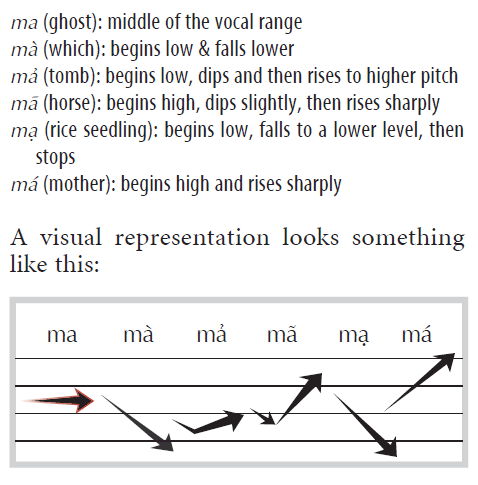
I enjoy reading about the various things you both enjoy in your travels. Really lends true feeling to the places rather than just having pictures like so many other travel shows. Thanks for sharing!
Great recap.
Indonesia was a little nuts with the scooters as well. Got a couple of shots:
http://www.roamthepla.net/blog/20120108-bali-bikes
I would have felt so uncomfortable with the hotel having my passport as well. That would have driven me crazy! 🙂